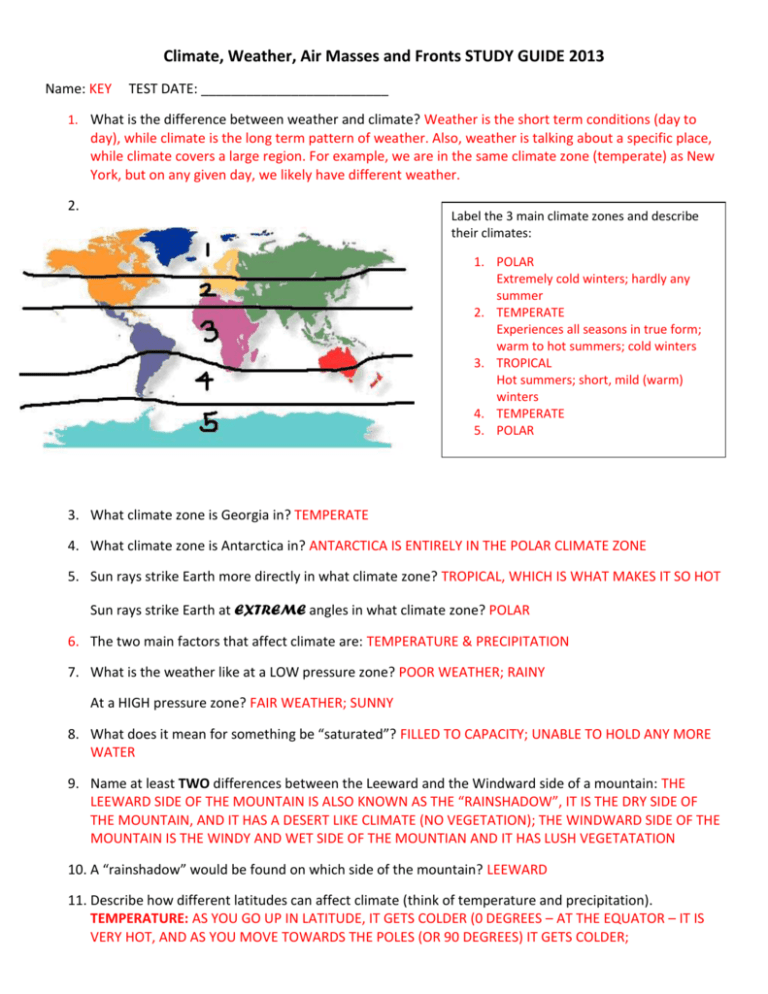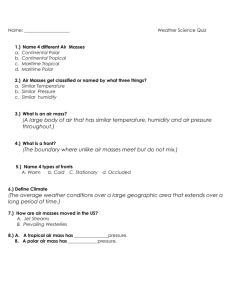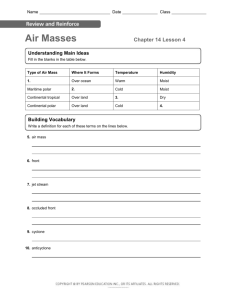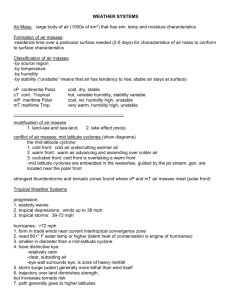Climate, Weather, Air Masses and Fronts STUDY GUIDE 2013
advertisement

Climate, Weather, Air Masses and Fronts STUDY GUIDE 2013 Name: KEY TEST DATE: _________________________ 1. What is the difference between weather and climate? Weather is the short term conditions (day to day), while climate is the long term pattern of weather. Also, weather is talking about a specific place, while climate covers a large region. For example, we are in the same climate zone (temperate) as New York, but on any given day, we likely have different weather. 2. Label the 3 main climate zones and describe their climates: 1. POLAR Extremely cold winters; hardly any summer 2. TEMPERATE Experiences all seasons in true form; warm to hot summers; cold winters 3. TROPICAL Hot summers; short, mild (warm) winters 4. TEMPERATE 5. POLAR 3. What climate zone is Georgia in? TEMPERATE 4. What climate zone is Antarctica in? ANTARCTICA IS ENTIRELY IN THE POLAR CLIMATE ZONE 5. Sun rays strike Earth more directly in what climate zone? TROPICAL, WHICH IS WHAT MAKES IT SO HOT Sun rays strike Earth at EXTREME angles in what climate zone? POLAR 6. The two main factors that affect climate are: TEMPERATURE & PRECIPITATION 7. What is the weather like at a LOW pressure zone? POOR WEATHER; RAINY At a HIGH pressure zone? FAIR WEATHER; SUNNY 8. What does it mean for something be “saturated”? FILLED TO CAPACITY; UNABLE TO HOLD ANY MORE WATER 9. Name at least TWO differences between the Leeward and the Windward side of a mountain: THE LEEWARD SIDE OF THE MOUNTAIN IS ALSO KNOWN AS THE “RAINSHADOW”, IT IS THE DRY SIDE OF THE MOUNTAIN, AND IT HAS A DESERT LIKE CLIMATE (NO VEGETATION); THE WINDWARD SIDE OF THE MOUNTAIN IS THE WINDY AND WET SIDE OF THE MOUNTIAN AND IT HAS LUSH VEGETATATION 10. A “rainshadow” would be found on which side of the mountain? LEEWARD 11. Describe how different latitudes can affect climate (think of temperature and precipitation). TEMPERATURE: AS YOU GO UP IN LATITUDE, IT GETS COLDER (0 DEGREES – AT THE EQUATOR – IT IS VERY HOT, AND AS YOU MOVE TOWARDS THE POLES (OR 90 DEGREES) IT GETS COLDER; PRECIPITATION: AT THE LOW PRESSURE ZONES (0 AND 60 DEGREES) WE WILL HAVE LOTS OF RAIN; AT OUR HIGH PRESSURE ZONES (30 AND 90 DEGREES) WE WILL HAVE SUNNY WEATHER (remember: high and dry ) 12. An AIR MASS is a large body of air with relatively uniform temperature and moisture characteristics. 13. What kind of air masses form over water? MARITIME (MOIST) 14. List the 4 different air masses below. Then, LABEL the air masses on the picture to the left. 1. MARTIME TROPICAL – MOIST AND WARM 2. MARITIME POLAR – MOIST AND COLD 3. CONTINENTAL TROPICAL – DRY AND WARM 4. CONTINENTAL POLAR - DRY AND COLD KEY: *Remember that we name air masses based off of 2 things: Temperature and Moisture MOISTURE: MARTIME means its MOIST/WET CONTINENTAL means its DRY TEMPERATURE: POLAR means its COLD TROPICAL means its WARM/HOT 15. Which air mass affects Georgia’s summers? THE MARITIME TROPICAL AIR MASS BRINGS HOT, HUMID SUMMERS TO GEORGIA 16. Continental polar and continental tropical air masses tend to have air that is typically DRY, while maritime polar and maritime tropical typically have MOIST/ HUMID air. 17. Tropical air masses form over WARM, HOT regions, while polar air masses form over COLD regions. 18. The boundary between two air masses of different densities is a FRONT. 19. What are the FOUR types of fronts? COLD FRONT, WARM FRONT, STATIONARY FRONT, OCCLUDED FRONT 20. Describe what happens when we have an occluded front. A COLD AIR MASS (WHICH MOVES FASTER THAN WARM AIR MASSES) CATCHES UP TO AND OVERTAKES A WARM FRONT. THIS CAUSES THERE TO BE TWO COLD AIR MASSES PUSHING IN ON A WARM AIR MASS, WHICH WILL EVENTUALLY CAUSE THE WARM AIR MASS TO BE PUSHED UP; THE WARM AIR WILL COOL OFF, CONDENSE, AND CAUSE A LOT OF PRECIPITATION, WHILE THE COLD AIR MASSES CAUSE COLDER TEMPERATURES AT THE SURFACE 21. Why do we call a stationary front a stationary front? BECAUSE THERE IS ESSENTIALLY NO MOVEMENT; THE COLD AND WARM AIR MASSES MEET, BUT THERE IS NOT ENOUGH FORCE FOR ONE TO OVERTAKE THE OTHER SO THEY REMAIN STATIONARY (NOT MOVING) 22. What kind of weather does a stationary front bring? DAYS OF STEADY PRECIPITATION AND CLOUDS 23. At what type of front might we see a tornado form? A COLD FRONT; REMEMBER, A COLD FRONT HAS A STEEP SLOPE, WHICH MEANS THAT WHEN THE COLD FRONT HITS THE WARM AIR, THE WARM AIR IS FORCED STRAIGHT UP QUICKLY; THIS CAUSES FAST MOVING CONVECTION CURRENTS (MIXING OF WARM AND COLD AIR), AND IN TURN CREATES VIOLENT STORMS (TORNADOES AND/OR BAD THUNDERSTORMS – WHICH IS ALSO WHY WE SEE CUMULONIMBUS CLOUDS AT THIS FRONT) 24. Describe at least 3 differences between WARM fronts and COLD fronts. Warm Front: 1. Has a shallow, less steep slope (see your diagram) 2. Does not cause violent storms like a cold front does 3. The warm air mass is advancing and moving over the cold air mass 4. Leaves behind warmer weather once the front passes through Cold Front: 1. Has a steep slope (see your diagram) 2. Causes violent storms, such as thunderstorms and tornadoes 3. The cold air mass is advancing and pushing itself under the warm air mass 4. Leaves behind cooler weather once that front passes through 25. List 5 factors that affect precipitation for a climate, and 5 factors that affect the temperature for a climate. Next to each, write a brief phrase explaining each. (Example: Latitude – as latitude increases (go from equator to poles), temperature decreases.) FACTORS THAT AFFECT PRECIPITATION 1. Latitude – 0 and 60 degrees are low pressure, which means it tends to be rainy more often. 30 and 90 degrees are low pressure, which means it tends to be sunnier. 2. Nearness to a large body of water – the closer you are to the coast, the closer you are to where evaporation and condensation (water cycle) are taking place so you will receive more rain. 3. If you are further inland, or landlocked, you will receive less rain. 4. If you are on the leeward side of the mountain, you are in the “rainshadow” and will receive little rain. The leeward side of the mountain is the dry side that is like a desert. 5. If you are on the wet, windward side of the mountain (the side that the wind is blowing towards/ on) you will receive more rain. FACTORS THAT AFFECT TEMPERATURE 1. Latitude: as you move away from the equator, temperature decreases. 2. If you are near the coast, you will have a smaller range in temperature (ex: low of 58, high of 65) because water heats/cools slower than land, so that water will help regulate temperatures. If you are landlocked, you will have a wider range in temperature (ex: low of 35, high of 62) because land heats/cools quickly, so the temperature on land will constantly be rising and falling. 3. If you are on the windward side of the mountain you will have cooler temperatures because the windward side receives a breeze/wind. If you are on the leeward side, you will have warmer temperatures because you do not receive any breezes/winds. 4. Elevation: the higher you go in the atmosphere, the colder the temperatures get. For example, it is colder at the top of a mountain than it is at the bottom. 5. The east coast (where we live) has a warm current causing the east coast to have warmer temperatures, whereas the west coast (California) has a colder current, which gives California a nice, cool climate. 26. What is the weather like in the southern part of Florida? Low pressure – it’s sunny and dry. 27. What kind of pressure is over California? HIGH, represented by the H 28. What kind of pressure is over northern Florida? LOW 29. What front is over the middle of the United States? Cold front, which is represented by the line with triangles (the line with bumps represents a warm front)









